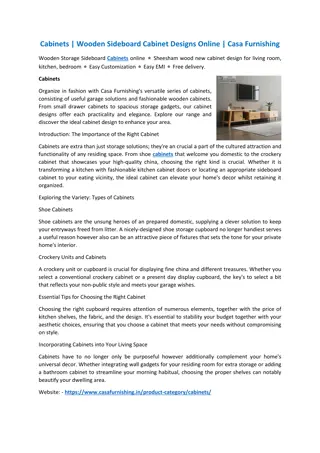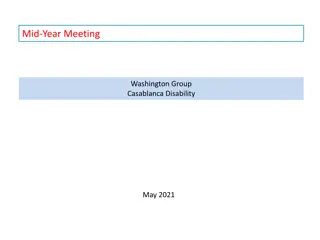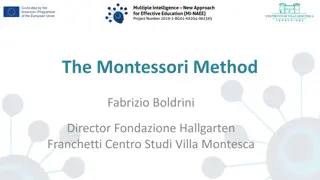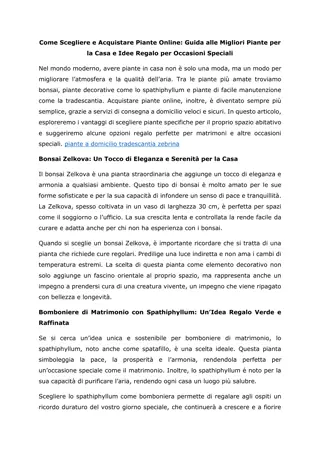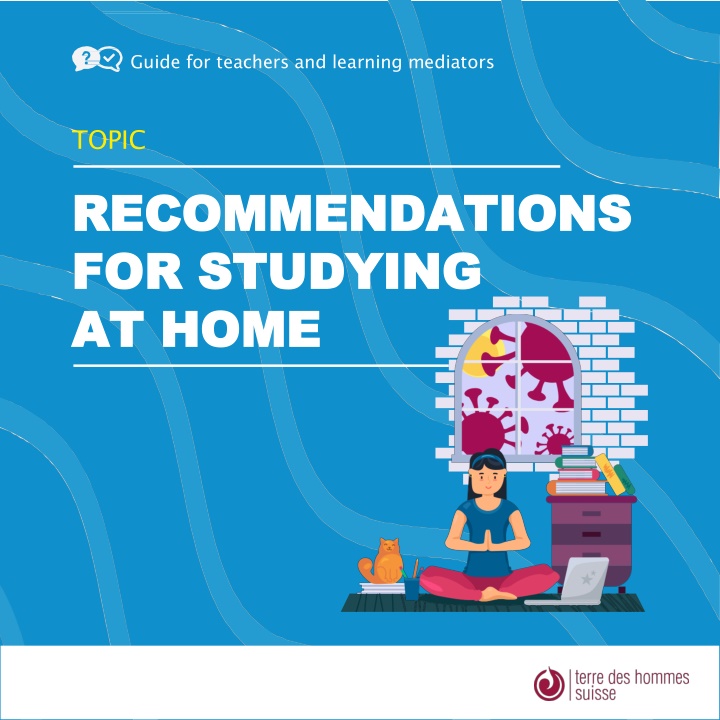
Effective Recommendations for Studying at Home During COVID-19 Crisis
Discover valuable recommendations and guidance for facilitating studying at home amidst the COVID-19 crisis. This informative material assists teachers and learning mediators in engaging students in productive study habits and environments from their homes. Adapted for various age groups, this digital educational resource aims to promote learning in the current challenging context.
Download Presentation

Please find below an Image/Link to download the presentation.
The content on the website is provided AS IS for your information and personal use only. It may not be sold, licensed, or shared on other websites without obtaining consent from the author. If you encounter any issues during the download, it is possible that the publisher has removed the file from their server.
You are allowed to download the files provided on this website for personal or commercial use, subject to the condition that they are used lawfully. All files are the property of their respective owners.
The content on the website is provided AS IS for your information and personal use only. It may not be sold, licensed, or shared on other websites without obtaining consent from the author.
E N D
Presentation Transcript
Guide for teachers and learning mediators TOPIC RECOMMENDATIONS RECOMMENDATIONS FOR STUDYING FOR STUDYING AT HOME AT HOME
PRESENTATION PRESENTATION The crisis generated by COVID-19 has had a direct impact on national education. In order to ensure that schoolchildren continue their education, education is being developed in the distance mode and will continue to do so for a few more months. This has meant that students have witnessed the merging of the school and family environment: the home is now also a study space. With the aim of contributing to the education of students throughout the country, from the Education for Sustainable and Solidarity Development Program (EDUSO) of Terre des Hommes Suisse, we share the following digital educational material that encourages students to generate spaces and habits that favor study from their homes. This material is part of a "Virtual Pedagogical Kit", which includes brochures, spots and other digital materials. In particular, this is a support aimed at teachers and learning mediators. It details the sequence of a short (approximately 15 minutes) informative and learning session. The session can be carried out with children and adolescents of various ages. It is can be adapted for use with primary and secondary school students. It should be noted that this material represents a guideline for the teacher, who is free to discern which aspects best apply to the reality of the group he or she is leading and to adapt the activities and the time assigned to each of them in order to guarantee learning. Likewise, it is a digital material designed to be used in a WhatsApp group or other virtual platforms. Graphic and audiovisual content is shared through links, which are used to inform, generate reflection and promote useful learning in the current context. We hope to contribute to the strengthening of citizenship and personal students to protect their lives and health, in order to establish a link between educational activities and the challenges of the COVID-19 situation. development skills in 2 2
FACT SHEET 1 FACT SHEET 1 Recommendations for studying at home I. General Information Module Module COVID COVID- -19 and education 19 and education Subject Subject Studying at home Purpose Purpose Motivate students to create the best possible conditions for studying at home. Axis Axis Health care and resilience building Citizenship exercise for risk reduction and conflict management. Coexistence and good use of resources in the home and community environment. Approach Approach Rights-based building in the family and responsibility in the home. approach: dialogue and consensus- 3 3
Value Value Dialogue Concertation Responsibility Duraci n Duraci n estimad estimad 20 minutes Personal and Social Education Area Area Competence Competence Build your identity. Evidence of Evidence of learning learning Share your weekly study schedule 4 4
II. Preparatory actions You can prepare for the session by visiting this web portal, where you will find an infographic with updated figures on Peruvian education. Remote Remote Classes https://larepublica.pe/sociedad/2020/04/06/aprendo-en-casa-horarios- programacion-en-tvperu-y-radio-nacional-de-clases-remotas-desde- lunes-6-de- abril/ Classes for for Schoolchildren," Schoolchildren," available available at at: : Review the guide and adapt the proposed messages, dynamics and activities to the platform you will use to conduct the session. For example, if you are using a videoconferencing platform such as Zoom, you can ask students to raise their hands to participate. 5 5
III. Guidelines for developing the session with students ACTiVITY ACTiVITY TIEE TIEE A A. . BEGINNING BEGINNING: : PROBLEMATIZATION PROBLEMATIZATION. . 4 minutes Greet the students. Begin by explaining the agreements for harmonious coexistence (allow everyone to express their ideas and attend to them with respect, interrupting the group). participate actively without Then, tell them that today they will see some recommendations that will help them develop study strategies at home. Use Use the In order to take care of the health of the members of the educational community (students and teachers), on-site classes in schools throughout the country have been suspended and have given way to distance learning. the next next message message: : For approximately 8 million children and adolescents a space in their homes has become their new classroom. Share with everyone: Do they feel they can concentrate well at home? Do you study in the same place every day? What is your favorite space to study, and why? 6 6
B. DEVELOPMENT: INFORMATION ANALYSIS B. DEVELOPMENT: INFORMATION ANALYSIS Share Card 1 or Card 2, depending on the language of the students. 6 minutes Card 1 "Four tips for studying at home." Document available at: https://drive.google.com/ file/d/1dKY0uCxBy21OXiGYPU5 t_ mnLMRTp1AAc/ view?usp=sharing Card 2 Card 2 "Four tips for studying at home". Document available at: https://drive.google. com/file/d/1L7NvzMQN1i R- 3J15lltbM6gdbvjBTS3T/ view?usp=sharing 7 7
In reviewing the tips, he emphasizes the importance of physical activity. Use the next message: Use the next message: Physical activity is important to keep us active and active even indoors. The 3-minute breaks, concentration, are the perfect opportunity to exercise our body. What kind of activities can you do in your 3-minute breaks? besides contributing to 8 8
C C. . CLOSING CLOSING: : DECISION Encourage students to follow these tips in order to adapt more easily to the new situation they are living these months and that will last longer. DECISION MAKING MAKING. . 7 minutes Finally, ask them to create a study schedule for the week and share it with the group. 9 9
More information: c.barrantes@terredeshommessuisse.ch Daniel A. Carri n N 866 1 piso, Magdalena del Mar, Lima. Tel fono: 01-463-1911 https://terredeshommessuisse.org.pe https://www.facebook.com/tdhsperu


